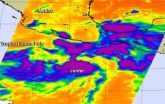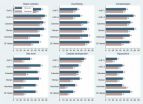(Press-News.org) Malvern, Pennsylvania, September 16, 2014 – Neuronetics, Inc., today announced that results of a study designed to assess the long-term effectiveness of NeuroStar TMS Therapy in adult patients with Major Depressive Disorder (MDD) who have failed to benefit from prior treatment with antidepressant medications, were published online in The Journal of Clinical Psychiatry. The study found that TMS treatment with the NeuroStar TMS Therapy System induced statistically and clinically meaningful response and remission in patients with treatment resistant MDD during the acute phase of therapy, which were maintained through one year of follow-up. At the end of acute treatment, 62 percent of patients achieved symptomatic improvement while 41 percent reported complete remission. At 12 months, 68 percent of patients achieved symptomatic improvement while 45 percent reported complete remission. Maintenance of benefit was observed under a pragmatic regimen of continued antidepressant medication and TMS reintroduction for symptom recurrence.
"The durability of NeuroStar TMS Therapy demonstrated by this robust, real-world study is remarkable, as it's not typical to see durability of long-term benefit in patients who have treatment resistant forms of depression," said Dr. David Dunner, M.D., Director of the Center for Anxiety and Depression in Mercer Island, WA, and Professor Emeritus at the University of Washington in Seattle. "The publication of these findings is an important validation for the sustained efficacy of NeuroStar TMS Therapy in a majority of patients with depression who have not found relief through antidepressant medication."
With 42 clinical practices participating, 307 patients with a primary diagnosis of unipolar, non-psychotic major depressive disorder and who had failed to receive benefit from prior antidepressant medication, received NeuroStar TMS Therapy.
The objectives of this study were to assess the change in depressive symptomatology and functional capacities across the duration of acute and long-term follow-up treatment with NeuroStar TMS. Of the patient population, 257 patients completed their acute TMS treatment, then were tapered from their acute treatment regimen and consented to long-term observation over 52 weeks.
Clinical assessments were based on data obtained at three, six, nine and twelve months using the clinician-rated Clinical Global Impression Severity of Illness (CGI-S), and the patient-rated Patient Health Questionnaire (PHQ-9) and Inventory for Depressive Symptomatology-Self Report (IDS-SR).
Neuronetics, Inc. is building upon the robust clinical evidence base for the use of NeuroStar TMS Therapy in patients with depression. Most recently, Neuronetics initiated an open-label study to evaluate the safety and efficacy of NeuroStar in patients with MDD who are suffering from post-partum depression. Neuronetics also completed a 12-month randomized study on the utility of TMS as maintenance therapy.
INFORMATION:
About NeuroStar TMS Therapy®
The NeuroStar TMS Therapy System is indicated for the treatment of Major Depressive Disorder in adult patients who have failed to receive satisfactory improvement from prior antidepressant medication in the current episode. NeuroStar TMS Therapy is a non-systemic (does not circulate in the bloodstream throughout the body) and non-invasive (does not involve surgery) form of neuromodulation. It stimulates nerve cells in the brain by delivering highly-focused MRI-strength magnetic field pulses which lead to activation of cortical and deep brain structures known to be involved in mood regulation. The treatment is available by prescription and typically administered daily for 4-6 weeks.
The NeuroStar TMS Therapy System was FDA-cleared in 2008 on the basis of the largest randomized controlled trial evaluating TMS in depression. In an NIMH-funded, independent, randomized controlled trial, patients treated with TMS using a clinical trial version of the NeuroStar TMS System were four times more likely to achieve remission compared to patients receiving sham treatment (P=0.0173, odds ratio = 4.05). The most common side effect of NeuroStar TMS Therapy is pain or discomfort at or near the treatment site. It is contraindicated in patients with non-removal conductive metal in or near the head. This device has not been evaluated for durability of antidepressant effect in controlled clinical trials.
Over 600 NeuroStar Systems are now in operation across the U.S. and more than 20,000 patients have received treatment. The NeuroStar TMS Therapy System is CE Marked and is approved in several countries worldwide.
For full safety and prescribing information, visit http://www.NeuroStar.com.
About Depression
Major depressive disorder is one of the most common mental disorders in the United States. It affects about 25 million Americans, and it's estimated that about four million patients do not benefit from standard treatments for depression, even after repeated treatment attempts. People with depression may experience a range of physically and emotionally debilitating symptoms, including anxiousness, sadness, irritability, fatigue, changes in sleep patterns, loss of interest in previously enjoyable activities and digestive problems.
About the Study
The study was designed to assess the long-term effectiveness of NeuroStar TMS Therapy in naturalistic clinical practice settings over 52 weeks following a clinically beneficial acute treatment course. The study population spanned 42 clinical practices with a cumulative total of 307 patients with a primary diagnosis of unipolar, non-psychotic major depressive disorder, who had failed to receive benefit from prior antidepressant medication.
NeuroStar TMS Therapy was administered to patients as determined by the evaluating physician, consistent with labeled use. Patients who completed acute NeuroStar TMS Therapy were tapered from their TMS regimen and observed through 52 weeks of follow-up. Clinical assessments (CGI-Severity of Illness, PHQ-9 and IDS-SR) were obtained at three, six, nine and twelve months. Concurrent medication use and TMS reintroduction for recurrent symptoms was recorded and summarized during the long-term follow-up.
Compared with baseline, there was a statistically significant reduction in mean [SD] CGI-S, PHQ-9 and IDS-SR total scores at the end of acute treatment (5.1 [0.9] versus 3.2 [1.5], 18.3 [5.2] versus 9.6 [7.0], and 45.7 [11.0] versus 27.4 [15.8], all P END
Journal of Clinical Psychiatry: Long-term benefit of NeuroStar TMS Therapy in depression
Largest clinical study evaluating durability of treatment with the NeuroStar shows depression patients maintained remission through 52 weeks
2014-09-16
ELSE PRESS RELEASES FROM THIS DATE:
NASA spots center of Typhoon Kalmaegi over Hainan Island, headed for Vietnam
2014-09-16
NASA's Aqua satellite saw Typhoon Kalmaegi's center near northern Hainan Island, China when it passed overhead on September 16 at 06:00 UTC (2 a.m. EDT). Hours later, the storm crossed the Gulf of Tonkin, the body of water that separates Hainan Island from Vietnam, and was making landfall there at 11:30 a.m. EDT.
The Moderate Resolution Imaging Spectroradiometer or MODIS instrument aboard Aqua captured a picture of the typhoon that shows the center near the northern end of Hainan Island, China, while the storm stretches over the mainland of southeastern China, east into ...
Computerized emotion detector
2014-09-16
Face recognition software measures various parameters in a mug shot, such as the distance between the person's eyes, the height from lip to top of their nose and various other metrics and then compares it with photos of people in the database that have been tagged with a given name. Now, research published in the International Journal of Computational Vision and Robotics looks to take that one step further in recognizing the emotion portrayed by a face.
Dev Drume Agrawal, Shiv Ram Dubey and Anand Singh Jalal of the GLA University, in Mathura, Uttar Pradesh, India, suggest ...
Newborn Tropical Storm Polo gives a NASA satellite a 'cold reception'
2014-09-16
The AIRS instrument aboard NASA's Aqua satellite uses infrared light to read cloud top temperatures in tropical cyclones. When Aqua passed over newborn Tropical Storm Polo off of Mexico's southwestern coast it got a "cold reception" when infrared data saw some very cold cloud top temperatures and strong storms within that hint at intensification.
Polo formed close enough to land to trigger a Tropical Storm Watch for the southwestern coast of Mexico. The watch was issued by the government of Mexico on September 16 and extends from Zihuatanejo to Cabo Corrientes, Mexico. ...
EARTH Magazine: The Bay Area's next 'big one could strike as a series of quakes
2014-09-16
Alexandria, Va. — Most people are familiar with the Great 1906 San Francisco Earthquake and are aware of the earthquake risk posed to the Bay Area — and much of California — by the San Andreas Fault. Most people are not aware, however, that a cluster of large earthquakes struck the San Andreas and quite a few nearby faults in the 17th and 18th centuries. That cluster, according to new research, released about the same amount of energy throughout the Bay Area as the 1906 quake. Thus, it appears that the accumulated stress on the region's faults could be released in a series ...
New research decodes virus-host interactions in ocean dead zones
2014-09-16
A complex web of interaction between viruses, bacteria, and their environment is becoming ever more untangled by a growing international collaboration between Matthew Sullivan, associate professor in the University of Arizona's Department of Ecology and Evolutionary Biology and Steven Hallam from the University of British Columbia in Vancouver, Canada.
"Bacteria are drivers of nutrient and energy cycles that power the earth," Sullivan said. "As the climate is changing, so are the environments these bacteria live in, and they in turn loop back to impact their environments. ...
New research shows tornadoes occurring earlier in 'Tornado Alley'
2014-09-16
BOZEMAN, Mont. -- Peak tornado activity in the central and southern Great Plains of the United States is occurring up to two weeks earlier than it did half a century ago, according to a new Montana State University study whose findings could help states in "Tornado Alley" better prepare for these violent storms.
Tornado records from Nebraska, Kansas, Oklahoma, and northern Texas – an area of high tornado activity dubbed "Tornado Alley" -- show that peak tornado activity is starting and ending earlier than it did 60 years ago.
Peak tornado activity, which occurs ...
Long-term results of RTOG 0236 confirm good primary tumor control, positive 5-year survival rates
2014-09-16
San Francisco, September 15, 2014—Patients with inoperable, early-stage lung cancer who receive stereotactic body radiation therapy (SBRT) have a five-year survival rate of 40 percent, according to research presented today at the American Society for Radiation Oncology's (ASTRO's) 56th Annual Meeting. Such a positive survival rate is encouraging considering that historically conventional RT resulted in poor tumor control for patients with inoperable lung cancer. This study is an update of RTOG 0236, originally published in 2010 , and also conducted by the original researchers ...
Politics divide coastal residents' views of environment, UNH research finds
2014-09-16
DURHAM, N.H. – From the salmon-rich waters of Southeast Alaska to the white sand beaches of Florida's Gulf Coast to Downeast Maine's lobster, lumber and tourist towns, coastal residents around the U.S. share a common characteristic: their views about coastal environments divide along political lines. That's a primary finding of a new study by University of New Hampshire sociologists published this month in the journal Society & Natural Resources.
"We found a lot of environment-related differences from place to place to place. Each environment is different so that's just ...
Artworks are people!
2014-09-16
Not all things are created equally. We don't view a Picasso sculpture in the same way we look at a hammer, for example — no matter how fancy the hammer.
The reason? We see the Picasso more as a person than an object, according to new research from the University of Chicago Booth School of Business.
And in some cases, we make distinctions between artworks — say, an exact replica of a piece created by the artist, versus one created by a different artist.
Art, in other words, is an extension of the creator, write Professor Daniel M. Bartels of Chicago Booth, and Professor ...
For electronics beyond silicon, a new contender emerges
2014-09-16
Cambridge, Mass. – September 16, 2014 – Silicon has few serious competitors as the material of choice in the electronics industry. Yet transistors, the switchable valves that control the flow of electrons in a circuit, cannot simply keep shrinking to meet the needs of powerful, compact devices; physical limitations like energy consumption and heat dissipation are too significant.
Now, using a quantum material called a correlated oxide, Harvard researchers have achieved a reversible change in electrical resistance of eight orders of magnitude, a result the researchers ...
LAST 30 PRESS RELEASES:
University of Oklahoma researcher awarded funding to pursue AI-powered material design
Exploring how the visual system recovers following injury
Support for parents with infants at pediatric check-ups leads to better reading and math skills in elementary school
Kids’ behavioral health is a growing share of family health costs
Day & night: Cancer disrupts the brain’s natural rhythm
COVID-19 vaccination significantly reduces risk to pregnant women and baby
The role of vaccination in maternal and perinatal outcomes associated with COVID-19 in pregnancy
Mayo Clinic smartwatch system helps parents shorten and defuse children's severe tantrums early
Behavioral health spending spikes to 40% of all children’s health expenditures, nearly doubling in a decade
Digital cognitive behavioral treatment for generalized anxiety disorder
Expenditures for pediatric behavioral health care over time and estimated family financial burden
Air conditioning in nursing homes and mortality during extreme heat
The Alps to lose a record number of glaciers in the next decade
What makes a good proton conductor?
New science reporting guide published for journalists in Bulgaria
New international study reveals major survival gaps among children with cancer
New science reporting guide published for journalists in Turkey
Scientists develop a smarter mRNA therapy that knows which cells to target
Neuroanatomy-informed brain–machine hybrid intelligence for robust acoustic target detection
Eight SwRI hydrogen projects funded by ENERGYWERX
The Lundquist Institute and its start-up company Vitalex Biosciences Announces Strategic Advancement of Second-Generation fungal Vaccine VXV-01 through Phase 1 Trials under $40 Million Competitive Con
Fine particles in pollution are associated with early signs of autoimmune disease
Review article | Towards a Global Ground-Based Earth Observatory (GGBEO): Leveraging existing systems and networks
Penn and UMich create world’s smallest programmable, autonomous robots
Cleveland researchers launch first major study to address ‘hidden performance killer’ in athletes
To connect across politics, try saying what you oppose
Modulating key interaction prevents virus from entering cells
Project explores barriers to NHS career progression facing international medical graduates
Jeonbuk National University researchers explore the impact of different seasonings on the flavor perception of Doenjang soup
Two Keck Medicine of USC Hospitals named Leapfrog Top Teaching Hospitals
[Press-News.org] Journal of Clinical Psychiatry: Long-term benefit of NeuroStar TMS Therapy in depressionLargest clinical study evaluating durability of treatment with the NeuroStar shows depression patients maintained remission through 52 weeks



